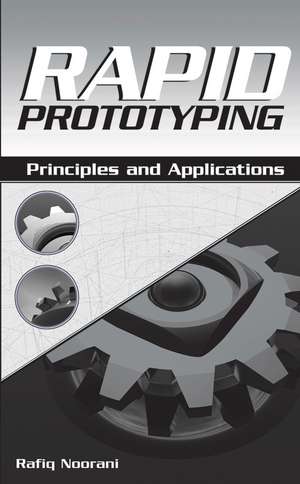Rapid Prototyping – Principles and Applications
Autor RI Nooranien Limba Engleză Hardback – 7 noi 2005
Preț: 1036.74 lei
Preț vechi: 1420.19 lei
-27% Nou
Puncte Express: 1555
Preț estimativ în valută:
198.40€ • 215.44$ • 166.66£
198.40€ • 215.44$ • 166.66£
Carte tipărită la comandă
Livrare economică 22 aprilie-06 mai
Preluare comenzi: 021 569.72.76
Specificații
ISBN-13: 9780471730019
ISBN-10: 0471730017
Pagini: 400
Dimensiuni: 167 x 240 x 26 mm
Greutate: 0.66 kg
Ediția:New.
Editura: Wiley
Locul publicării:Hoboken, United States
ISBN-10: 0471730017
Pagini: 400
Dimensiuni: 167 x 240 x 26 mm
Greutate: 0.66 kg
Ediția:New.
Editura: Wiley
Locul publicării:Hoboken, United States
Public țintă
Ideal for u pper level undergraduate and graduate level students in schools of mechanical, industrial, manufacturing, chemical, electrical, civil or architectural engineering. Design engineers at manufacturing industries and government bodies (NASA, NIST, etc.), associations (ASME, SME) and researchers at universities and government labs (Sandia) either designing, developing or researching new products and processes.Cuprins
Preface.
Acknowledgments.
About the Author.
1 Introduction.
1.1 Introduction.
1.2 World of RP.
1.3 History of RP.
1.4 Development of RP Systems.
1.5 Applications in Education and Industry.
1.6 Case Study: Fabricating a Prototype Using 3D Printing.
1.7 Summary.
2 Principles of Rapid Prototyping.
2.1 Principles of Automated Processes.
2.2 RP Fundamentals.
2.3 Problems with STL File Format.
2.4 Other Translators.
2.5 Case Study: Designing and Prototyping a Spur Gear.
2.6 Summary.
3 Liquid-Based RP Systems.
3.1 Classification of RP Systems.
3.2 3D Systems' Stereolithography Apparatus (SLA).
3.3 D-MEC's Solid Creation System.
3.4 CMET Solid Object UV Laser Plotter.
3.5 Summary.
4 Solid-Based RP Systems.
4.1 Stratasys' Fused Deposition Modeling Systems.
4.2 Helysis Laminated Object Manufacturing System.
4.3 Solidscape's 3D Printing and Deposition Milling.
4.4 3D Systems' Multijet Modeling System.
4.5 KIRA's Selective Adhesive and Hot Pass (SAHP) System.
4.6 Summary.
5 Powder-Based RP Systems.
5.1 3D Systems' Selective Laser Sintering.
5.2 MIT's Three-Dimensional Printing.
5.3 Z Corporation's Process (Z406 System).
5.4 Soligen's Direct Shell Production Casting.
5.5 EOS's Laser Sintering Systems.
5.6 e-Manufacturing using Laser Sintering.
5.7 Summary.
6 Materials for Rapid Prototyping.
6.1 Introduction.
6.2 Types of Materials.
6.3 Liquid-Based Materials.
6.4 Solid-Based Materials.
6.5 Powder-Based Materials.
6.6 Case Study.
6.7 Summary.
7 Reverse Engineering.
7.1 Introduction.
7.2 Measuring Devices.
7.3 CAD Model Construction from Point Clouds.
7.4 Data-Handling and Reduction Methods.
7.5 Applications and Trends.
7.6 Case Study.
7.7 Summary.
8 Rapid Tooling.
8.1 Introduction.
8.2 Indirect Methods of RT.
8.3 Direct Methods of RT.
8.4 Case Study: Sheet-Metal Forming by RT.
8.5 Summary.
9 Medical Applications in Rapid Prototyping.
9.1 Introduction.
9.2 Medical Applications of RP.
9.3 Types of Medical Imaging.
9.4 Software for Making Medical Models.
9.5 Medical Materials.
9.6 Other Applications.
9.7 Summary.
10 Industry Perspectives.
10.1 Guidelines for Implementation.
10.2 Operating Issues.
10.3 Managing Issues.
10.4 Service Bureaus.
10.5 Rapid Prototyping Consortia.
10.6 Present and Future Trends.
10.7 Summary.
11 Research and Development.
11.1 Improvement of FDM Process Using Design of Experiment.
11.2 Improvement of Part Accuracy.
11.3 Effects of Cryogenic Processing on RP Materials.
11.4 New Technologies.
11.5 Summary.
Appendix A: RP Resources.
Appendix B: Worldwide RP System Manufacturers.
Appendix C: Rapid Tooling Technology Suppliers.
Appendix D: RP Software Developers.
Appendix E: RP Material Suppliers.
Glossary.
List of Abbreviations.
Index..










